On Wednesday, I presented this stitch challenge to you, for the Trilby Stitch as illustrated in Embroidery Stitches by Mary Wilkinson, published in 1912.
Today, we’re going to look at it a little more closely.
I’m also going to put my neck out and probably say a few things that will shock and scandalize you. Brace yourselves!
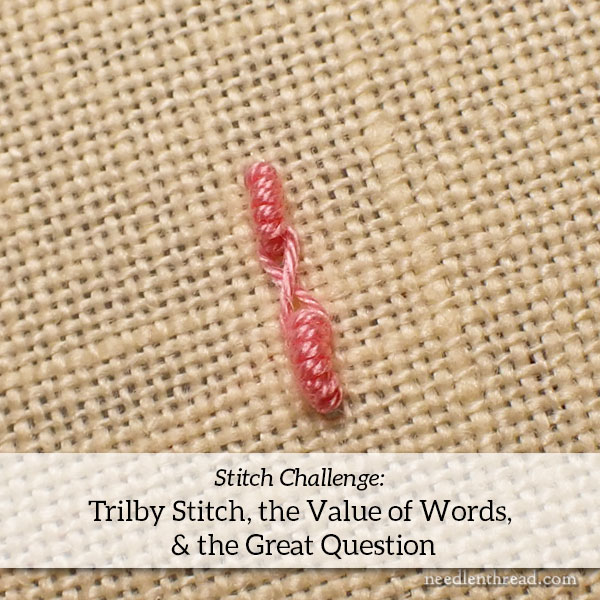
When studying Mary Wilkinson’s instructions and illustrations for what she calls “Trilby Stitch,” we can probably all agree that the outcome we expect should be similar to what you see in the photo above.
Impressive outcome? Trust me – it’s not what you think!
Let’s work through it together and talk about it as we go. I’ll share my thoughts, more or less, as I was playing around with the stitch.
(Ok, I might not share all my thoughts, because some might not be worthy of repetition among sooooch refined company…if you get my drift. If you tried the stitch, you probably get my drift.)
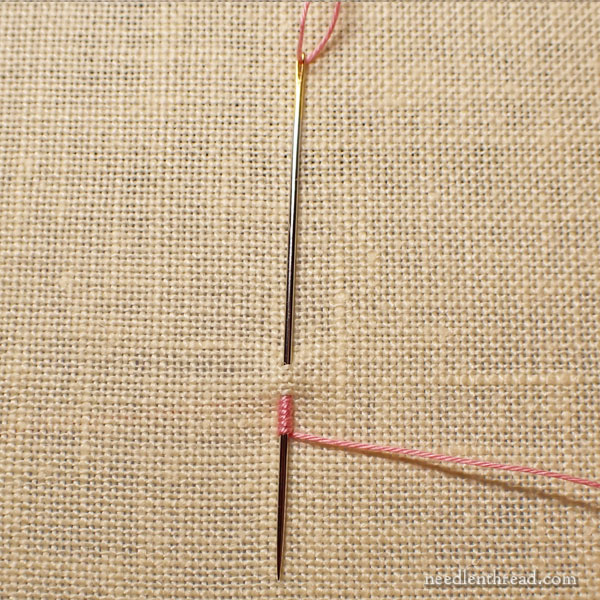
I’m working with a milliner needle, coton a broder #25 in pink, on a delectable yellow linen that I’m actually working a completely different sampler on at the moment, but I scooted over on the sampler to take these photos.
Starting off with the initial diagram and reading her instructions, my first configuration looks like the set up for a typical bullion knot.
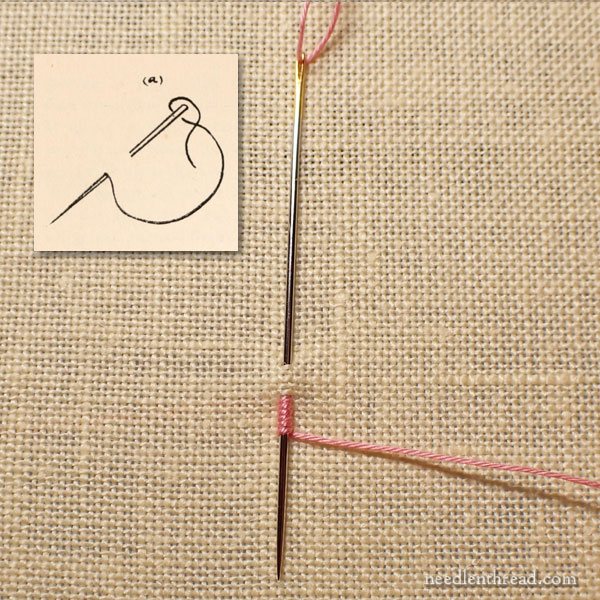
She says: “Insert the needle as for French knots.
Meh – my needle is already wrapped when I insert for French knots. She sets her French knot up like a very small bullion knot. I didn’t catch this the first time I wrote about her French knot illustration, but when I started going through all the steps very carefully, I caught it and I corrected my article from Wednesday where I mentioned it. Her illustration for the French knot shows the set up for what we know as a bullion knot, albeit a very small one.
Then she says: “Wind the thread six times round the point of the needle…”
And so I did, and that’s where we are, above.
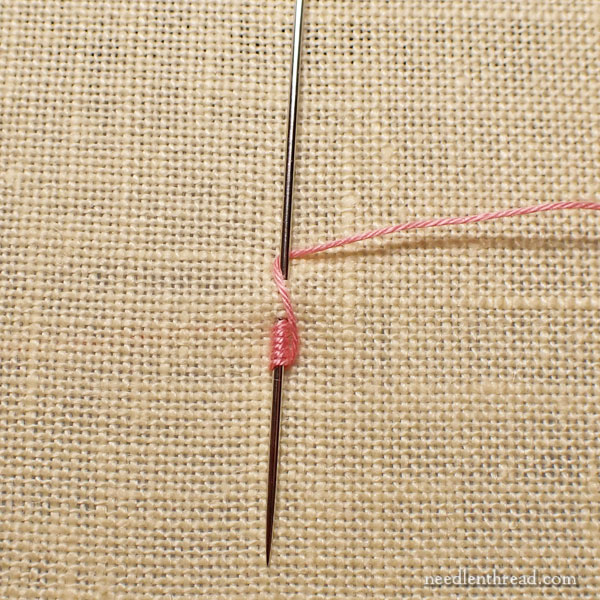
Then she says: “…then six times round the head…”
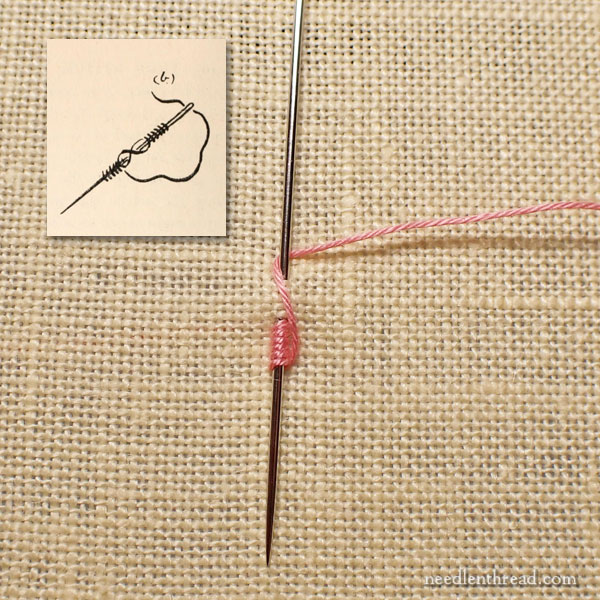
And to get to the head, we understand that there’s this wrapped cross over, because it’s in the illustration.
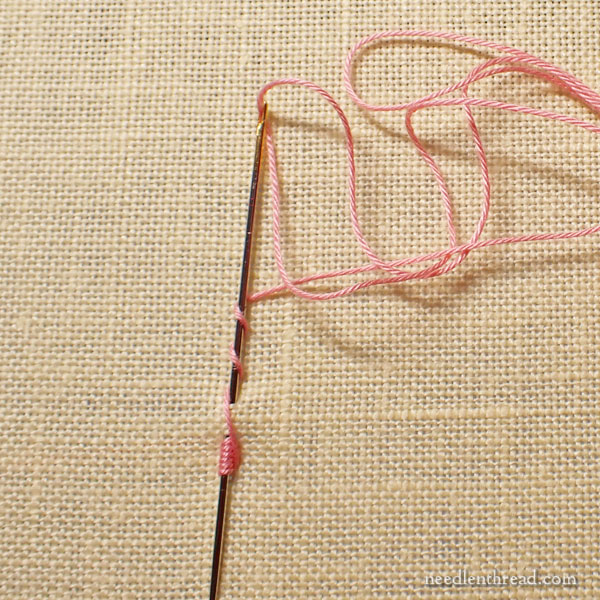
What she doesn’t mention is that wrapping the thread six times around the head of the needle would be a heck of a lot easier if I unthread the stupid needle.
(Did I just say “stupid needle”?)
At this point, my in-head commentary starts slipping into statements like, “This would be a heck of a lot easier if I unthread the stupid needle. Grumble. Grumble. Grumble.”
I know the needle is not stupid.
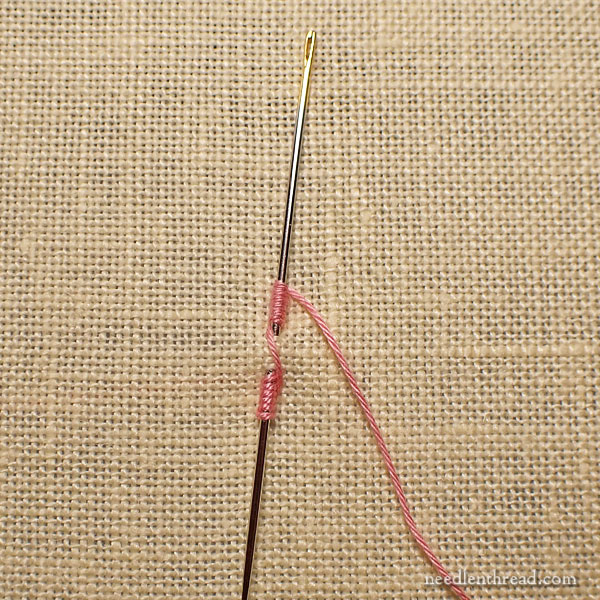
Ah. Isn’t that much nice-and-neater?
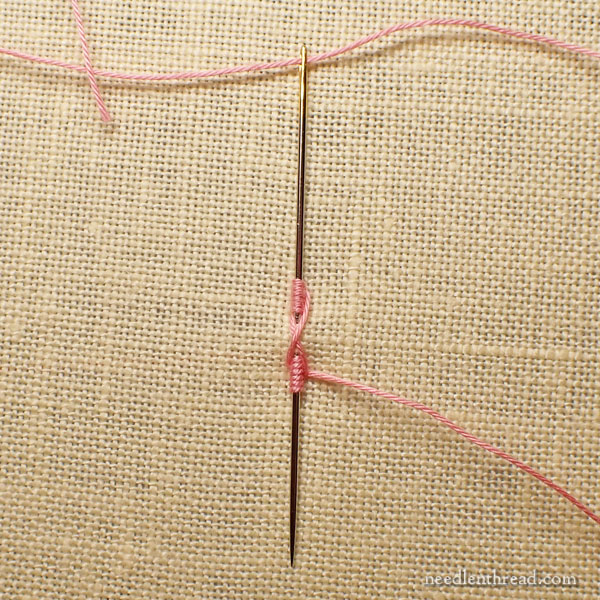
And now, she says: …then once round the point again.”
And so I did, and I rethreaded the needle.
There are no more illustrations of progress at this point. There are simply three illustrations of what we assume she means to be the outcome of the stitch.
She says: “Hold the stitches firmly with the thumb…”
Which is pretty much what you do with a bullion knot as you pull through, so I did that.
She continues: “…and draw the needle through.”
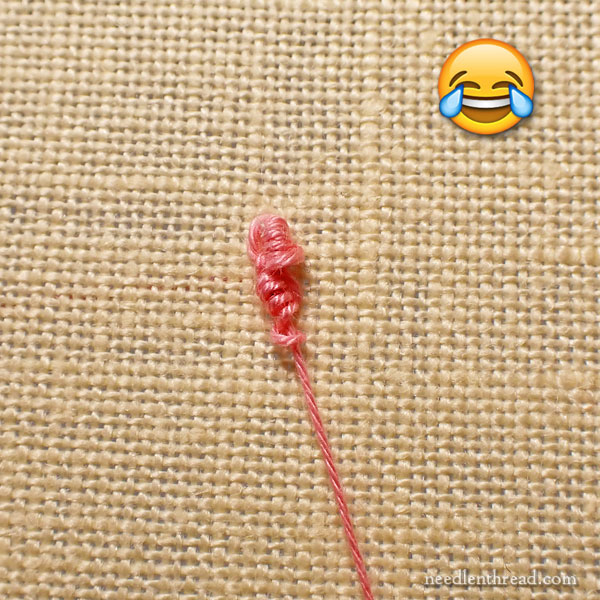
And so I did.
Well, dang! That doesn’t look like the illustration!
(I didn’t really expect it to.)
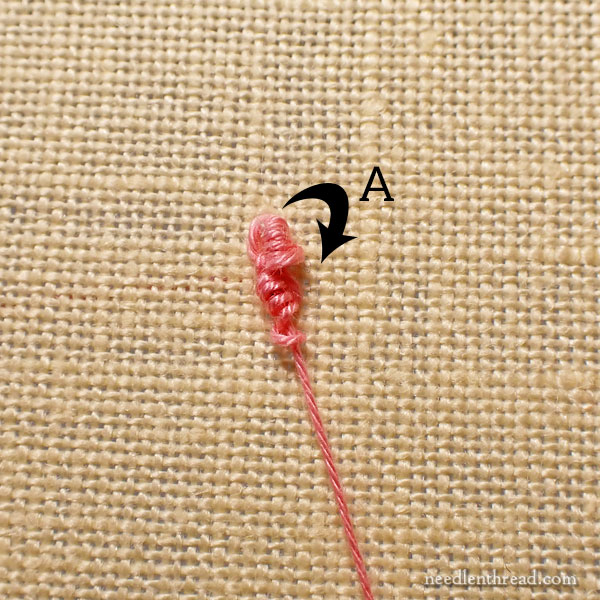
Logically – and especially if we have had experience with bullions, drizzle stitch, cast-on stitch, double cast-on stitch, and the like – we know that, when we pull that thread through, the top “head” (we’ll call it “A”) has to go down in the direction of pulling. There is no choice in that matter, for that part of the stitch.
You cannot pull the thread through that configuration, and expect the top section of windings to stay in the same vertical, upright position. It has to pull down, if you are pulling in the direction that the needle is pointing.
And what other direction would you pull in? You have to get the needle out of the fabric, and that’s the direction you have to go.
Now, let’s pause and consider more of Wilkinson’s words:
“…two opposite clusters of knots…”
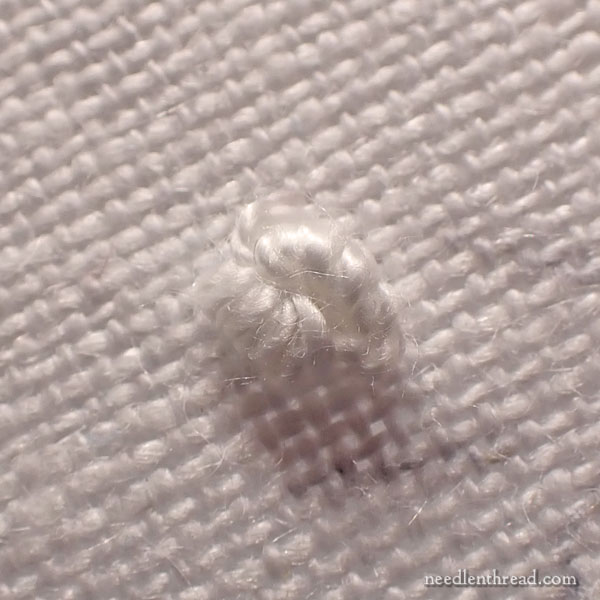
(That’s pearl cotton #5 – it was the best turn out that I had.)
I was able to work this stitch and get a cluster of two knots. Would I call them “two opposite clusters” of knots? Well, not really. It’s a snuggly little cozy cluster of two knots.
And what happened to the “plaited thread in between”?
It ends up behind the knots. If you’re using this configuration to make a cluster of two bullion knots, the only reason the plait would be there is because you have to pass the thread somehow from the lower section of the needle to the upper section of the needle in a way that allows the thread to sensibly hold on while you’re pulling through.
In the end, it’s not really visible.
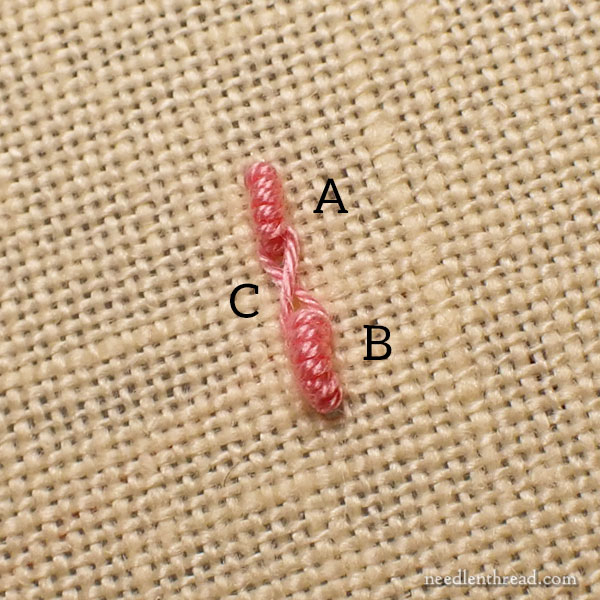
But then, what is this?
This is two separately-worked bullion knots, with a thread wrapped between the two in a figure 8. It took me … 15 seconds? and zero frustration!
If I wanted the configuration of the stitch as it’s illustrated in Wilkinson’s book, that’s how I’d achieve this configuration.
But that elicits the question – the One Question that I think is the Greatest Question we ever ask ourselves:
Why?
A few of you wrote in and asked what a stitch that looks like this can be used for. Why, in other words, would you stitch it?
If you place the bullions far enough apart (say, the width of a quarter-inch ribbon), and you have that figure 8 between them, you could use it for securing a ribbon that you might run behind it. You could work them in a sequence or band, resulting in a decoration of bullion knots along the edges of the ribbon, with a criss-cross over the ribbon.
I didn’t have time to work that out. But it would work.
I guess you could work the joined stitches in isolation for a decorative something-or-other. You could probably zig-zag a line of them for a decorative line of stitching.
But… would you construct them as she describes and illustrates? I don’t think so. It would be way inefficient, but more obviously… it wouldn’t actually work!
Words
If you consider these words in her written instructions: “The result is two opposite clusters of knots…” you can get that result with the stitch, but they don’t look like the tidy bullion knots vertically aligned opposite each other. Instead, they look like two knots clustered together.
If I were wording that, for clarity, I wouldn’t say that they are “two opposite clusters of knots.” I would say “a cluster of two knots.”
And that elicits the Great Question again:
Why? You can stitch two bullion knots clustered together in a cozy configuration like the white one shown above by stitching two separate bullion knots clustered together in a cozy configuration.
Final Thoughts
I think, as written and illustrated, this stitch might be bunkum. I could be wrong! You’re most welcome to prove me so!
I don’t know if the author ever worked it out herself, or if the configuration just looked good to her, or if she learned of it from someone else and maybe wrote it down incorrectly, or just drew some conclusions about it… who knows.
But I do know this: If you want the outcome that’s illustrated, it’s just much easier to stitch two bullions and join them with a figure 8.
If you want two cozily clustered opposing knots, they, too, are easier to stitch as single bullions.
This is what I’d call a Stitch Glitch!
Just my take!
How’d you make out? Were you successful? Can you post pictures somewhere of your progress with results and share a link? Or perhaps drop me a line with photos? If you managed to successfully follow her instructions and illustrations and come out with the illustrated result, I’d love to see how you did it and the results!
And now, I’m off to work on that sampler I mentioned above… Oh, the things I have to show you!
Have a wonderful weekend!







Mary my first few attempts looked the same as yours. It was a teeny bit frustrating trying to figure it out. I’m relieved to hear that there may have been a mistake in the instructions. I will retry it using your instructions.
I failed a couple of times before looking at the calendar. I fully expected today’s post to read “APRIL FOOLS”
Hi Mary , thank you so much for this detailed analysis and instruction.
LOL! I was so looking forward to you showing us how it was done. Of course, mine folded up on themselves, as yours did and most of mine where a complete mess but I was quite pleased with this attempt worked in smooth passing thread (although I’m not sure that I will ever do another).
https://www.instagram.com/p/Cb0CxEoMCkI/
Can’t resist seeing the gold thread version as a fancy Mardi gras miniature mask that could be positioned over two google eyes or separate French or colonial knot “eyes”. And as a big fan of bullion stitches, I hope to get around to Mary’s easier solution eventually (focused on sewing a baby quilt for great great niece that arrived early)
Mary, I took one look at those instructions and the accompanying illustration and realized that I needed to just be patient and wait for your results because no way, no how was I ever going to get anything close to the result shown by following those directions! Thanks for investigating this for us and giving us an easy modern way to do it. I think your suggestion of making a row and using the crossover area to thread a ribbon is a lovely suggestion.
Mary, I tried to work it out in my head on Monday and saw a mess of threads in my head with the wrap above part. I had a great chuckle over your “dumb needle” part of the story. I also wondered what it would be used for. Thanks for delving into past books and articles to share with us some great info, new stitches and glitches. I so look forward to hearing from you each week.
I completely concur with your findings!!!
I tried that stitch. I did unthread the needle too. I am so glad for videos because those written instructions of hers did not help at all. Thanks for the challenge.
Haha! I said “stupid needle” too! Then “stupid tangled thread”. More than once. I wasn’t smart enough to unthread the needle. My results looked like your early attempts too. The bunched together weird knot. Not pretty. Won’t do it again.
Mwaaahhhhahahahah indeed!
Loved the challenge though.
Thank you for sending me down a rabbit hole. I did some digging and have two thoughts. First, this stitch could be used for heirloom lace edges similar to a bullion scalloped edge, but it would have a twisted picot in the middle. I haven’t had the chance to try it yet, but I will try to send you pictures soon.
‘Second and maybe more likely, although I am guessing at this point–I found a knitted trilby hat design online and these stitches would be a way to mend the hat or duplicate those stitches in embroidery form and maintain the integrity of the knitted stitching. If done, as pictured, the crossed area could be used for couching an extra yarn to create a striped effect and continue the line of stitching without having to stop and start each individual bullion stitch.
I love mystery searching that helps me review my own study of stitches and play in my books and stash of needles and threads. I’m going to try a couple of things and will let you know if I find anything productive.
TL;DR: read the words, pictures are vague guidelines at best
So I took a look at the book and found out a few things:
1. The drawings are inconsistent with the written descriptions. If you look at the French Knot, doing as she says makes a normal French Knot, but the drawing is.. ??? whatever that is (there appears to be a little backstitch underneath it, even)
2. Try as I might I couldn’t find her previous book “Art Needlework and Design” but I DID find “A cook book for the poor, the rich, the sick, the well” by likely her: https://archive.org/details/cookbookforpoorr00wilk/
3. There is no mention of who illustrated it, so I’m going to assume it was some rando from the publishing company, which would explain why the images don’t quite match the words. The illustrations are also quite inconsistent and mixes up when the thread is just a line or a pair of lines, sometimes the entire stitch is drawn, sometimes it’s just vaguely alluded to. (This is common in books from this era)
–160 “snailtrail stitch” for example works if you follow the words (though I wouldn’t work it quite how she says) it comes out what her words say, but the image looks more like some weird sort of couching.
–43 “crewel/stem stitch” she works bottom to top, “keeping the needle pointed down” which does in fact work, but the illustration is.. lacking, to say the least.
–68 “dumbbell stitch” is a good example: the vertical stitches are single lines, the horizontal stitches are pairs of lines. No instruction given, just a vague description (but kind of self explanatory anyway, in this case)
All this leads me to believe you’re right in your “couple cozy bullion knots” assumption (that while scrolling up to look at it I somehow read “Wilkinson’s knot” and thought that was a stitch name.. Perhaps it could be called that.)
That said, the book does offer some creative uses and ideas, so that’s nice.
P.S. searching that site for Mary E. and Mary Elizabeth from that time frame is a GREAT rabbit hole, do suggest, lots of good stuff pops up.
Snailtrail Stitch outcome (I kinda like it):
https://i.imgur.com/r7ucxug.png
(I have no shame, I found a random needle and random thread and did some tests on a random t-shirt that was on my floor and took a not good picture.)
Yes, I think it’s just coral stitch, or coral knot stitch. The funny thing is, it was already called coral stitch or coral knot stitch by then, in other publications. So her stitch names are definitely humorous, in a way!
(I am very bad at putting all the info I mean in one comment…)
Trilby is also a VERY popular novel from 1894-5, with Trilby being the main character’s name. So probably something to do with that.
I’m so glad to see your attempt looks like mine! It was so frustrating. I tried twice and threw it down in frustration. Knowing you had the same experience and were just as grumbly makes me feel a bit better. Thank you for your walk through and explaining a way to achieve the the look minus the frustration.